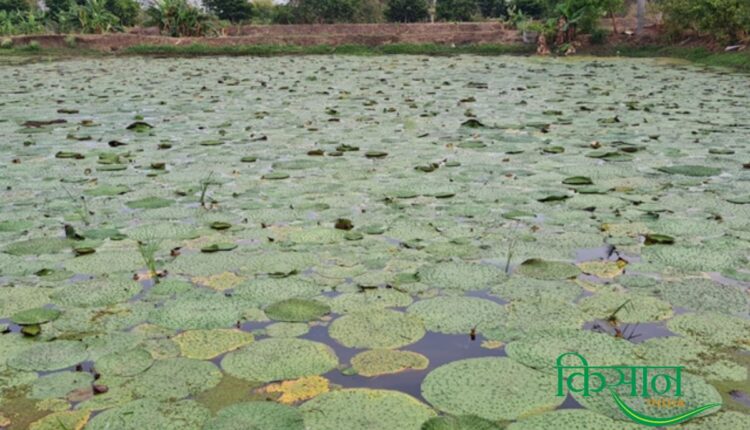Makhana Cultivation: National Research Center for Makhana towards innovation and development in Makhana cultivation
Makhana Cultivation: Realizing the need for change and improvement in various aspects of the agricultural sector in India, many institutions are working in this direction. The National Research Center for Makhana (NRCM), Darbhanga, is playing an important role in Makhana cultivation and its promotion. Makhana, which is usually eaten during fasting, is not only beneficial for health but has also become a profitable agricultural business for farmers. The center is continuously working to promote Makhana cultivation, its advanced technology, and Makhana-based industries.
Major center of advancement in Makhana cultivation
The National Research Center for Makhana (NRCM) aims to make Makhana cultivation more profitable and effective. Located in Darbhanga, this center is doing research in new varieties of Makhana, Makhana horticulture, and related areas. The high-yielding Makhana varieties and thornless water chestnut varieties developed by it have brought a new twist in the agriculture sector.
The center has also introduced water conservation and integrated agricultural practices to promote Makhana cultivation. The technology connecting Makhana and fish farming has also been developed by this center, which gives farmers an additional source of income. Apart from this, the center has also developed many Makhana-related equipment such as Makhana seed washing machine, seed grader, primary roasting machine and popping machine. These equipment have also been licensed for commercial use.
How is Makhana cultivated? (How is makhana cultivated?)
Makhana cultivation is an aquaculture method, which is done in various reservoirs and ponds. Clay loamy soil is considered ideal for makhana, and the water level should be 4-6 feet. There are many methods of makhana cultivation, of which pond method, direct sowing and transplanting method are prominent.
Pond method: This is the traditional technique of makhana cultivation. In this, makhana grows from last year’s seeds, and makhana is also cultivated in the pond along with fish farming, due to which farmers get additional fish.
Direct sowing: In this method, healthy seeds of makhana are sprinkled in the pond in December. After 35-40 days the seeds start growing, and after two to two and a half months the plants emerge on the surface of the water. In this method, it is necessary to take care of the distance and transplantation of the plants.
Transplanting method: In this method, healthy and new-born plants are transplanted between March and April. After 2 months, purple flowers start appearing on the plants and the fruits are fully ripe in 35-40 days. This method increases the yield of makhana.
How to prepare nursery of makhana?
Clay loam soil is used to establish a makhana nursery. For this, deep plowing 2-3 times is necessary in the field, and the right amount of nitrogen, phosphorus and potash is used for the growth of plants. After sowing makhana seeds in December, the plants are ready for transplantation by the end of March. There is a possibility of improvement in makhana cultivation and more production through makhana nursery.
Contribution of National Makhana Research Center in expansion of Makhana cultivation
National Makhana Research Center has achieved many important achievements in the field of makhana. From 2012 to 2023, NRCM has distributed 15,824.1 kg of high-yield makhana seeds to farmers, and it has trained farmers from states like Bihar, Uttar Pradesh, Chhattisgarh. More than 3,000 farmers have been trained on makhana cultivation, processing and marketing techniques. Apart from this, NRCM has also encouraged makhana-based industries, which has increased the income of local industries and farmers.
Farming of Makhana strengthens rural economy
Along with innovation in makhana cultivation, government schemes have also brought economic benefits to the farmers. The schemes of the Central Government and State Governments to promote makhana cultivation are proving to be beneficial for the farmers. Makhana cultivation is not only helping in increasing the income of farmers, but it is also strengthening the rural economy. Makhana related industries and processing units are expanding, generating new employment opportunities.
Financial Statement Assessing the Expenditures and Achievements of NRCM
The National Research Centre for Makhana (NRCM) has taken several important steps for innovation and advancement in Makhana cultivation. Here is a brief description of the money spent by NRCM and the work done by it:
| Financial Year | Expenditure (in lakhs) |
| 2023-24 | 265.00 |
| 2022-23 | 15.95 |
| 2021-22 | 17.87 |
| 2020-21 | 23.50 |
| 2019-20 | 18.00 |
| Total | 340.32 |
During this period, NRCM has distributed 15,824.1 kg of high-yielding Makhana seeds to various farmers, KVKs and institutions. Farmers of Bihar, Uttar Pradesh, Chhattisgarh and other states have benefited from these seeds.
Conclusion
Research and innovations done by the National Research Center for Makhana (NRCM) have given a new direction to Makhana cultivation. Makhana cultivation is not only increasing the income of farmers, but it is also empowering the agricultural economy of India. Various methods of Makhana cultivation, such as pond method, direct sowing and transplanting method, are providing more benefits to the farmers. Through Makhana nurseries and advanced techniques, this industry is moving forward and it has become a profitable agricultural business for the farmers.
Contact us – If farmers want to share any valuable information or experiences related to farming, they can connect with us via phone or WhatsApp at 9599273766 or you can write to us at “[email protected]”. Through Kisan of India, we will convey your message to the people, because we believe that if the farmers are advanced then the country is happy.



